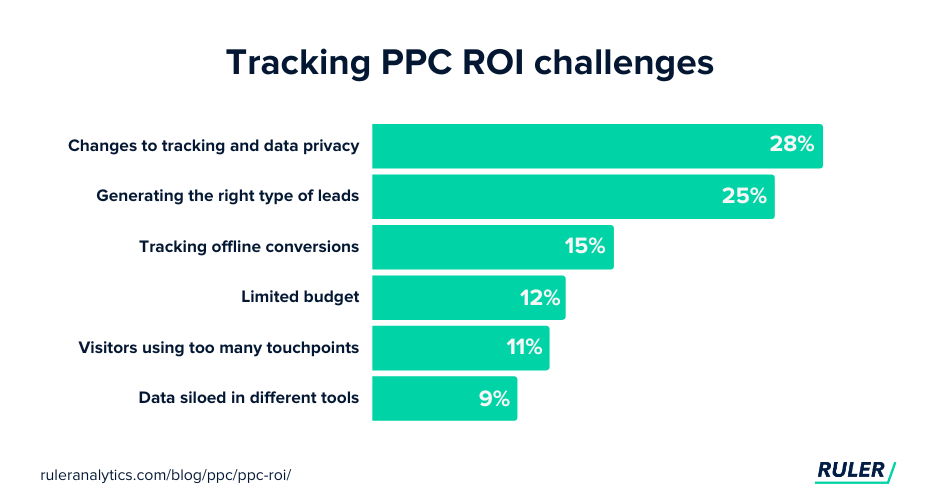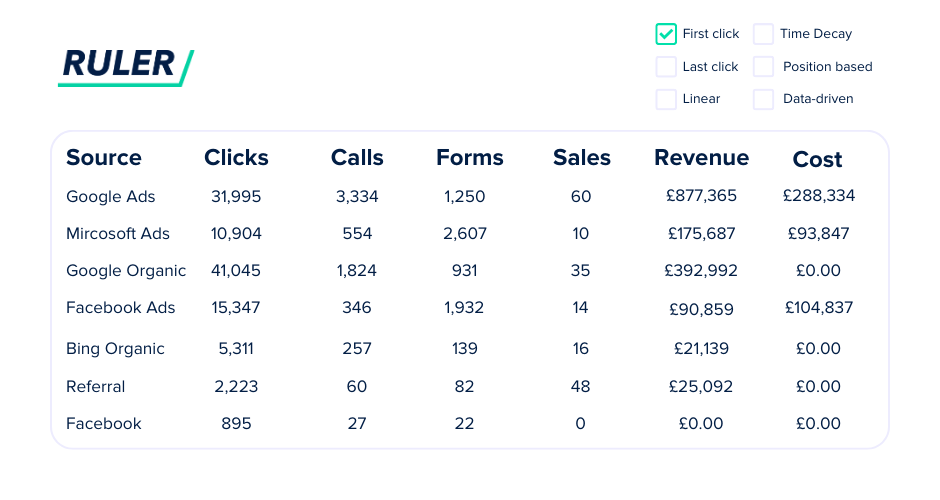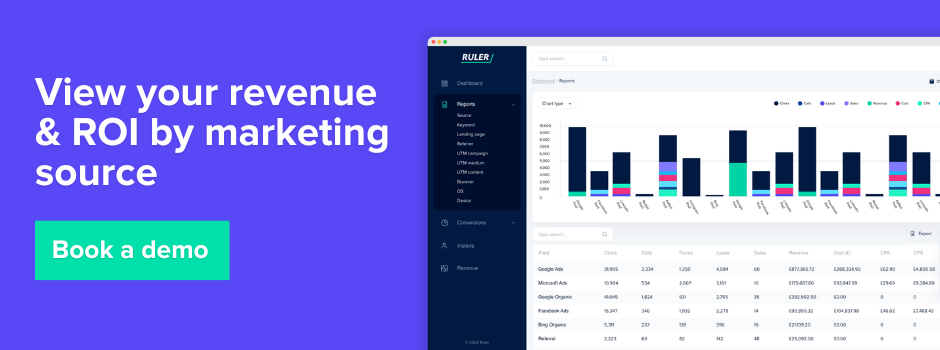Demonstrate the ROI of your PPC campaigns and prove that you’re attracting the right type of leads and customers.
It’s no secret, tracking PPC ROI is critical to your marketing success.
ROI is the most effective way to prove which campaigns have the highest impact on revenue income.
But, determining which PPC campaigns are giving the best ROI isn’t easy.
With consumers using more marketing touchpoints to research and purchase products and services, the process of gaining an accurate view of ROI has become an escalating challenge for advertisers.
In fact, during our survey, we found that just over half of marketers are confidently tracking marketing ROI.
As a marketing attribution provider, we wanted to help improve this. To achieve that, we reached out to PPC marketers and business leaders for their best tips, tools and practices for tracking PPC ROI.
For this article, we’ll discuss:
💡 TL;DR
Most marketers understand the importance of tracking ROI but struggle to do it effectively.
Some of the challenges of tracking ROI include visitors using too many touchpoints, limited budgets, and siloed data in different departments. However, the most significant challenge, according to experts, is changes to tracking and data privacy. The demise of third-party cookies has made it more challenging for marketers to track visitor interactions across different touchpoints, which has made it harder to track ROI.
Despite the challenges of data privacy, you can track ROI using methods such as UTM parameter tracking in hidden fields and dedicated landing pages. However, first-party attribution tracking is the most effective method. Ruler, for example, tracks the entire customer journey, from the initial touchpoint to close, and integrates with your CRM to show which PPC campaigns generate the most revenue. See how other businesses use Ruler to improve ROI.
PPC ROI is the process of attributing profit and revenue growth to the impact of your advertising campaigns. Being able to track and prove ROI is a priority, especially for advertisers.
Without tracking PPC ROI, you will not know which campaigns are working and which are underperforming. Tracking ROI validates whether or not your ads are worth spending on and helps justify budget allocation for ongoing and future campaigns.
Measuring PPC ROI is easy when you know how to do it.
Related: How to definitively prove your marketing ROI
“All you have to do is minus the cost of the PPC advertisement from the revenue you earned with clicks and then divide that number by the cost again. To get that number as a percentage, all you have to do is multiply it by 100,” says Teri Shern, Co-Founder at Conex Boxes.
As an equation, it looks like this:

This will give you a percentage that represents your PPC ROI and help you find your spot. For example, if sales increased to £2,000 and the PPC campaign cost £1,000, your ROI would be 100%.
If you’re an advertiser worth your salt, you’ll have come across ROAS at some point. Marc Stitt, Chief Marketing Officer at FMX, says, “When some advertisers talk about ROI, they’re often speaking about ROAS.”
Related: Why return on ad spend is important and how to track it
Many marketers mistakenly use ROAS as a proxy for ROI when measuring the revenue impact of marketing. On the surface, return on ad spend (ROAS) and return on investment (ROI) do look the same, but they are actually very different.
Dan Scalco, Owner at Food Box HQ, helps us explain how ROAS works: “ROAS is a quantitative evaluation of an ad campaign’s performance that is calculated by dividing the money spent by the gross income. Let’s say you spend $1,000 on a PPC campaign for a month and make $3,000 in revenue. This ROAS means that for every dollar spent, $3 in revenue is generated.”
Related: How to calculate ROAS and improve it
The formula for ROAS looks like this:

ROI is best for determining the overall health and profitability of your advertising endeavours and can include other expenses such as installation and maintenance. Whereas ROAS, on the other hand, focuses on the return of a particular campaign or ad.
Both metrics provide different insights into the profitability of your advertising campaigns and play a big part in increasing your company’s revenue.
Stephen Curry, CEO at CocoSign, tracks both ROI and ROAS to measure campaign success.
“As a SaaS, we have no cost for a product. We track our ROI by calculating ROAS. We calculate it by dividing the profit from our ad campaigns by the total cost of our campaigns. We focus on this metric because it tells us how much money we make from our ads. It also shows us what we can expect from our ads and if it is worth scaling them,” says Stephen.
PPC marketers have struggled for years to track their ROI, and only a few have managed to crack it.
With access to so much data, why are advertisers struggling to demonstrate their ROI?
According to our survey, it boils down to the following factors.

The feedback in our survey varied, but most of our respondents ranked changes to tracking and data privacy as the top challenge.
On March 3rd 2021, Google announced its plans to phase out third-party cookies and made it clear that it’s not building any alternate tracking identifiers.
Related: All you need to know about first-party cookies and third-party analytics
Digital advertisers have long relied on third-party cookies to collect analytics data and track consumer touchpoints. They’ve been around for quite some time, and it’s believed that 80% of advertisers depend on third-party cookies to track ad efficiency and ROI.
As you can imagine, Google’s announcement that it’ll no longer support third-party cookies sent shockwaves through the digital marketing and advertising world.
With the clock ticking on third-party cookies, many advertisers are at a crossroads to find alternative ways to track user activity and ROI.
Now that we’ve covered what PPC ROI is and the challenges of tracking it, here are some tried-and-tested tactics from experts:
“My tip for tracking ROI is to track goals or events that are important to your business,” says PPC & Google Ads Consultant Ryan Scollon.
Before tracking ROI, you’ll need to establish your goals.
Without clear goals, you’re essentially directionless.
Goals give you something to work towards and setting a clear timeframe with a start and end date is helpful to maintain motivation.
For example, let’s say your overall business objective is to increase revenue to £100,000.
You can set monthly, weekly, or even daily revenue goals regarding your PPC returns to ensure you’re contributing to the overall business objective.
“For lead gen campaigns, keep track of the contact info for the leads you generate via PPC. Then at the end of the month, ask the business owner (or check your own records) to see which leads turned into clients or sales,” says Adam Gingery, COO at Majux Marketing.
Tracking users individually is the best method to gain a singular view of your customer journeys and demonstrate ROI.
By monitoring and measuring the movements of specific users, you can acquire better data into which campaigns and ads are most valuable in driving leads and revenue.
If that’s true, why aren’t more marketers doing it?
Consumers today are using more touchpoints than ever to research and purchase products and services.
It’s believed that consumers use an average of almost six touchpoints during their journey, with nearly 50% regularly using more than four.
Customer journeys are becoming increasingly complex, and marketers are finding it impossible to keep up.
But with marketing attribution tools in place, it becomes a lot easier to track customer touchpoints, users’ behaviour and ROI.
Tools like Ruler, for example, track each anonymous visitor individually, record how that user found your site and track any subsequent visits or interactions with other marketing channels and campaigns.
It enriches your CRM with marketing source data, such as landing page, campaign, keyword, click ID, and cookie ID, so you can see which of your contacts were influenced by your PPC campaigns.
Once a lead converts into a customer, Ruler sends all of this data back to its dashboard, where you can use different multi-touch attribution models to credit revenue to the touchpoints that contributed the most.

“Ruler Analytics is a simple marketing attribution solution that helps firms see the big picture of their customer journeys. It’s ideal for those who want to show the impact of their PPC advertising on revenue generation,” says David Wurst, Owner & CEO at Webcitz.
💡 See how Ruler can help you improve your marketing ROI
Ruler’s powerful features, such as the revenue source and diminishing returns report, can help you prove ROI and boost the revenue impact of your marketing. Our blog shows you everything you need to know about using Ruler to track and forecast revenue. Or, get a personalised demo of Ruler and see how it can be tailored to your specific needs.
“The best way to track the ROI of your PPC campaign is by infusing your lead data into the CRM of your business. It is a brilliant way to understand their position in the conversion funnel,” says Jared Stern, CEO at Uplift Legal Funding.
One misconception is that CRM is just for sales.
But, advertisers can gather valuable information and benefit from the CRM too.
Related: What is the role of the CRM in marketing
All advertising platforms give you great detail on the performance of your campaigns, keywords and ads on traffic and conversion metrics.
But, “most of the time, marketers do not gain much information about true ROI from their PPC campaigns,” says Ravi Jasti, Digital Advisor at dJolt.
By integrating your PPC campaign data with your CRM or database systems, you’ll gain more in-depth details about your leads and customers.
Related: How to send lead source to your CRM
Over time, you can determine which ads and keywords drive the highest quality leads and convert them into actual revenue.
You can optimise your campaigns to drive the best possible results and grow your company faster.
Patrick Casey, Director of Growth Marketing at Felix Health, agrees: “By tracking leads throughout the conversion funnel, you can determine how many conversions you generated as a direct result of your PPC campaign.”
“My best tip to track the ROI of PPC campaigns is by setting dedicated landing pages. By doing so, you’ll ensure that only those people fill out your forms who came from your PPC campaign,” says David Clelland, Founder at Infiniti Tracking.
Related: Three easy ways to track your form submissions
If you’re not ready to invest in visitor level tracking tools, you do have a few alternative options.
The first option is to create a dedicated landing page to capture leads that discover your products and services through your paid channels only.
A PPC landing page is a standalone web page where visitors ‘land’ after clicking through on a pay-per-click ad.
They allow you to monitor the people who have clicked on one of your ads and help demonstrate the impact of your paid campaigns on leads and sales.
Before you set your landing page live, you must ensure that it’s not indexable for the search engines. This will isolate traffic, allowing you to validate how PPC is driving leads and revenue for your company.
Nate Tsang, Founder & CEO at Wall Street Zen, echoes this: “Make sure you add a ‘noindex’ tag to your page, so it doesn’t start ranking in the search engines. Make sure you link to it only from your PPC campaign.”
“UTM codes act as a tag and can offer far more detailed traffic source analytics if you’re running more than one campaign at a time, allowing you to have a firmer grasp on the true success of your efforts,” added Stephen Light, CMO Nolah Mattress.
The other option is to utilise UTM tracking.
By adding UTM parameters to your marketing links, you can track which traffic sources, campaigns, and keywords are driving the most traffic to your website.
Tools like Google Ads offer auto-tagging which makes your job easy.
Related: What is GCLID auto-tagging and how to use it
You can, however, build your own UTMs using Google’s URL builder.
After adding UTM parameters to your marketing links, you can use hidden fields in your forms to capture the UTM or GCLID values and send this data to your CRM along with your leads’ contact information.
This will give you some insight into which PPC variables are leading to the most conversions and revenue.
But while tracking UTM variables in hidden fields is easy to set up, there are some drawbacks to be aware of.
First, you only get information on leads who have clicked on a UTM click, so you probably won’t get much attribution information for channels like organic search, social, and referrals.
Second, UTMs can be lost when a visitor clicks on a link and then navigates to another page without making a conversion.
But remember, marketing attribution tools can help you to overcome these drawbacks by:
If you’re not tracking your PPC ROI, there’s a chance you’re throwing away your budget on ineffective ads that don’t move the needle.
With tools like Ruler, the process of tracking your PPC ROI couldn’t be any easier.
Ruler takes out the legwork by seamlessly attributing revenue to your marketing across multiple touchpoints, allowing you to focus on building and growing your company.
Want more information about Ruler? Read our guide on how Ruler attributes revenue to your marketing or book a demo and see it in action for yourself
